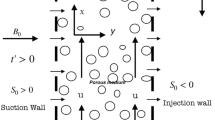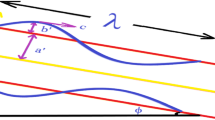Abstract
We investigated flow characteristics in a hydraulic coupling at different charged water conditions and speed ratios. Hence, simulations were performed for three-dimensional two-phase flow by using the VOF method. The realizable k-ε turbulence model was adopted. To resolve the interaction of passing blades of the primary and secondary wheels, simulations were conducted in the unsteady framework using a sliding grid technique. The results show that the water-air distribution inside the wheel is strongly dependent upon both amount of charged water and speed ratio. Generally, air is accumulated in the center of the wheel, forming a toroidal shape wrapped by the circulating water. The results also show that at high speed ratios, the solid-body-like rotation causes dry areas on the periphery of the wheels and, hence, considerably decreases the circulating flow rate and the transmitted torque. Furthermore, the momentum transfer was investigated through the concept of a mass flux triangle based on the local velocity multiplied by the local mixture density instead of the velocity triangle commonly used in a single-phase turbomachine analysis. Also, the mass fluxes along the radius of the coupling in the partially charged and fully charged cases were found to be completely different. It is shown that the flow rate at the interfacial plane and also the transmitted torque are closely related and are strongly dependent upon both the amount of charged water and speed ratio. Finally, a conceptual categorization together with two comprehensive maps was provided for the torque transmission and also circulating flow rates. These two maps in turn exhibit valuable engineering information and can serve as bases for an optimal design of a hydraulic coupling.
Similar content being viewed by others
References
M. J. Nunney, Light and heavy Vehicle Technology, Butterworth-Heinemann, Oxford, UK (2007) 317.
H. Huitenga and N. K. Mitra, Improving startup behavior of fluid couplings through modification of runner geometry: Part I-Modification of runner geometry and its effects on the Operation Characteristics, J. Fluids Eng., 122 (2000) 683–688.
H. Huitenga and N. K. Mitra, Improving startup behavior of fluid couplings through modification of runner geometry: Part II-Modification of runner geometry and its effects on the operation characteristics, J. Fluids Eng., 122 (2000) 689–693.
S. B. Ainley, R. D Flack, K. Brun and T. J Rovello, Laser velocimeter measurements in the pump of an automotive torque converter Part I-Effect of speed ratio, International J. of Rotating Machinery, 6 (3) (2000) 167–180.
A. Habsieger and R. D Flack, Flow characteristics at the pump–turbine interface of a torque converter at extreme speed ratios, International J. of Rotating Machinery, 9 (2003) 419–426.
R. D. Flack, S. B. Ainley, K Brun and L. Whitehead, Laser velocimeter measurements in the pump of an automotive torque converter Part II-effect of pump speed and oil viscosity, International J. of Rotating Machinery, 6 (3) (2000) 181–190.
U. Hampel, D. Hoppe, K.-H. Diele, J. Fietz, H. Holler, R. Kernchen, H.-M. Prasser and C. Zipper, Application of gamma tomography to the measurement of fluid distributions in a hydrodynamic coupling, Flow Measurement and Instrumentation, 16 (2005) 85–90.
M. J. Da Silva, Y. Lu, T. Suhnel, E. Schleicher, S. Thiele, R. Kernchen, K.-H. Diele and U. Hampel, Autonomous planer conductivity array sensor for fast liquid distribution imaging in a fluid coupling, Sensors and Actuators AL Physical, 147 (2008) 508–515.
N. Jain and A. Tiwari, Comparative study of fluid coupling for oil and water as working fluid, International J. of Engineering Research and Development, 8 (2013) 56–61.
J. Schweitzer and J. Gandham, Computational fluid dynamics in torque converter: validation and application, International J. of Rotating Machinery, 9 (2003) 411–418.
L. Fan, W. Ma and W. Cai, Thermal-hydraulic analysis of hydrodynamic coupling, Advances in Information Sciences and Service Sciences, 4 (2012) 393–399.
Y. Luo, Z. G. Zuo, H. G. Fan and W. L. Zhung, Numerical simulation of the two-phase flows in a hydraulic coupling by solving VOF model, IOP Conf. Ser.: Mater. Sci. Eng., Beijing, China(2013).
Y. Luo, L. H. Feng, S. H. Liu, T. J. Chen and H. G. Fan, Numerical comparisons of the performance of a hydraulic coupling with different pump rotational speeds, IOP Conf. Ser.: Mater. Sci. Eng., Beijing, China(2013).
N. Hur, W. J. Lee, C.-S. Chang and N.-W. Kang, Twophase flow analysis of a hydraulic coupling, ASME-JSMEKSME Joint Fluids Eng. Conf., Seoul, Korea(2015).
N. Hur, M. Moshfeghi and W. J. Lee, Flow and performance analyses of partially-charged water retarder, Computer and Fluids, http://dx.doi.org/10.1016/j.compfluid.2016.10.033.
C. Liu, C. Liu and W. Ma, RANS, detached eddy simulation and large eddy simulation of internal torque converters flows: A comparative study, Engineering Applications of Computational Fluid Mechanics, 1 (2015) 114–125.
CD-adapco, STAR-CCM+ Ver. 9.06.011 User Guide, London, UK(2014).
Author information
Authors and Affiliations
Corresponding author
Additional information
Recommended by Associate Editor Shin Hyung Rhee
Nahmkeon Hur is a Professor of Mechanical Engineering at Sogang University in Seoul, Korea and a Director of Multi-phenomena CFD Engineering Research Center (ERC) funded by National Research Foundation of Korea. He received his Ph.D. from Stevens Institute of Technology in 1988. His research interests include multiphysics and multi-dynamics CFD and their industrial applications.
Minhee Kwak received her B.S. and M.S. in Mechanical Engineering from Sogang University, Seoul, Korea in 2015 and 2017, respectively. Her study interests at CFD-ERC laboratory of Sogang University include multi-phase CFD analysis and applications.
Mohammad Moshfeghi received his B.S. and M.S. in Aerospace Engineering from Tehran Polytechnic in 2002 and 2005. His Ph.D. about flow control over wind turbine blades is from Xi’an Jiaotong University, Xi’an, China in 2013. His field of interest includes CFD simulations of multi-phase flows, turbomachineries and wind turbine aerodynamics.
Choon-Soo Chang is a Managing Director of the VS ENG in Seoul, Korea. He received his M.S. in Production Engineering from KAIST, Korea. As a Principal Engineer, he is responsible for the development of a variable speed hydraulic coupling.
Rights and permissions
About this article
Cite this article
Hur, N., Kwak, M., Moshfeghi, M. et al. Numerical flow analyses of a two-phase hydraulic coupling. J Mech Sci Technol 31, 2307–2317 (2017). https://doi.org/10.1007/s12206-017-0427-3
Received:
Revised:
Accepted:
Published:
Issue Date:
DOI: https://doi.org/10.1007/s12206-017-0427-3




